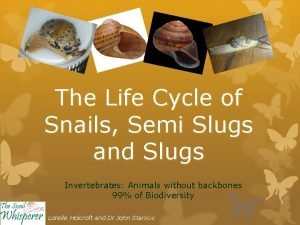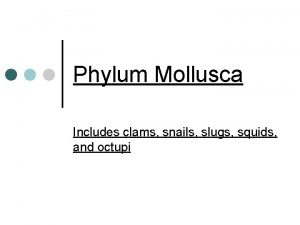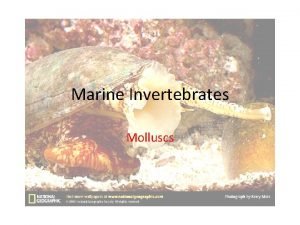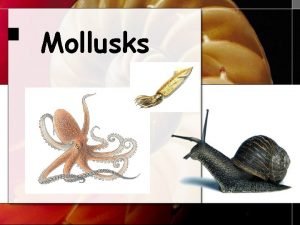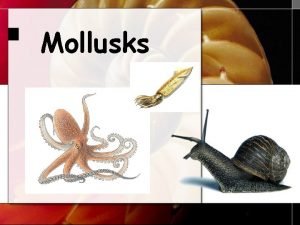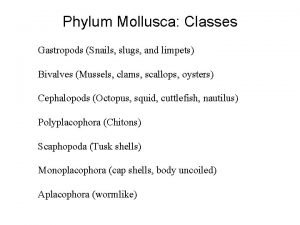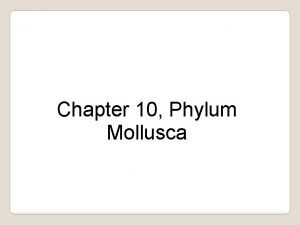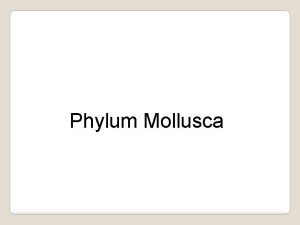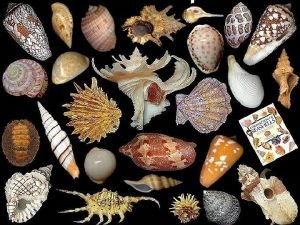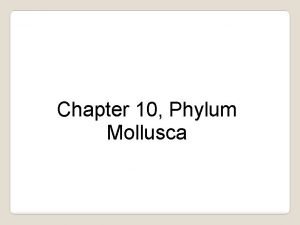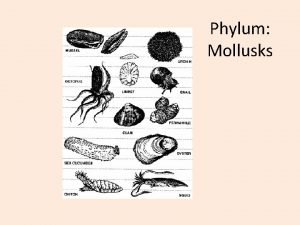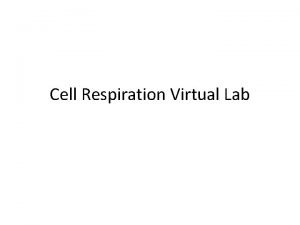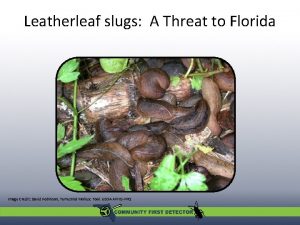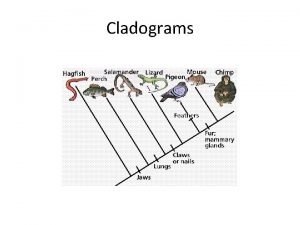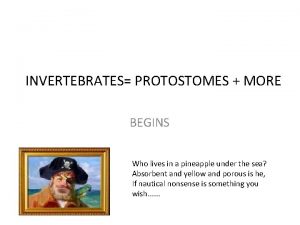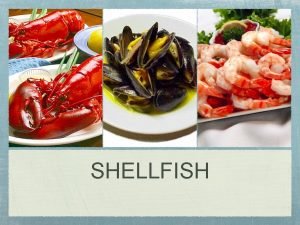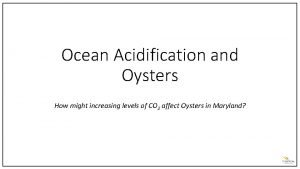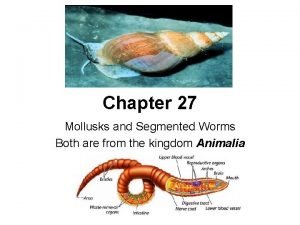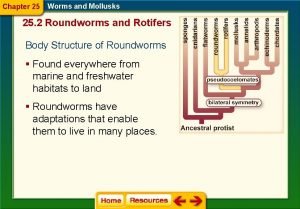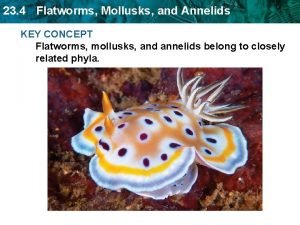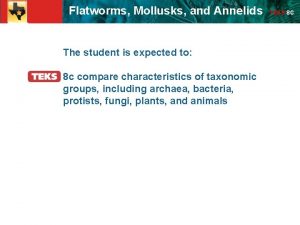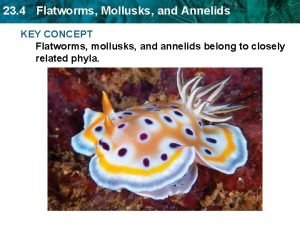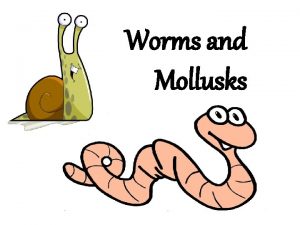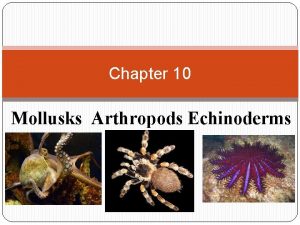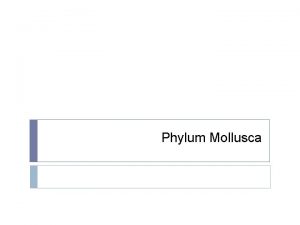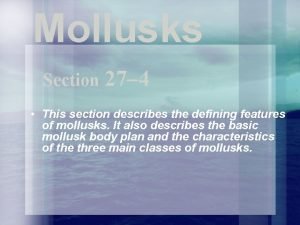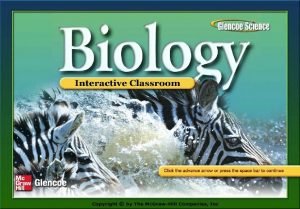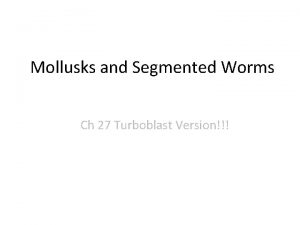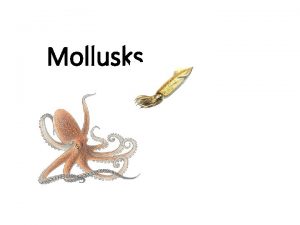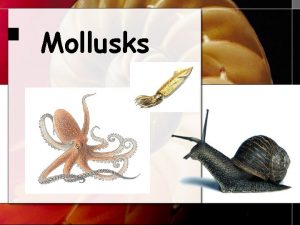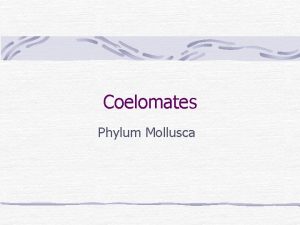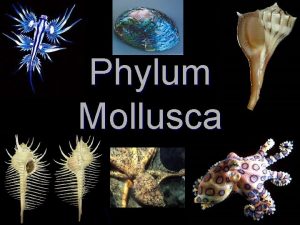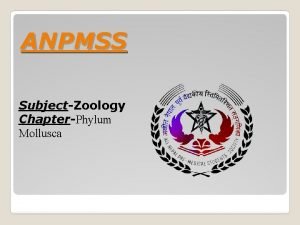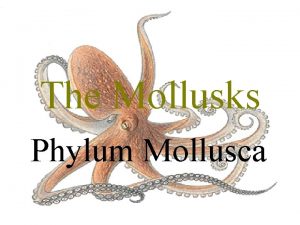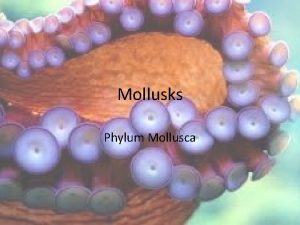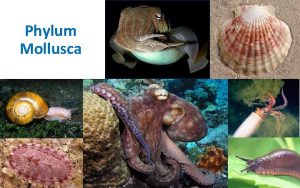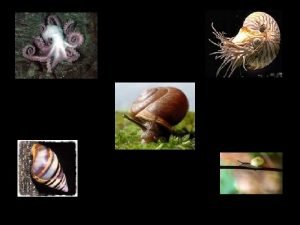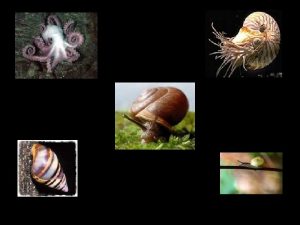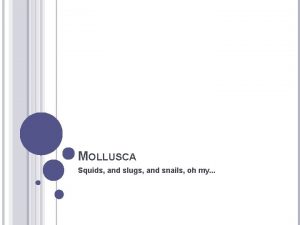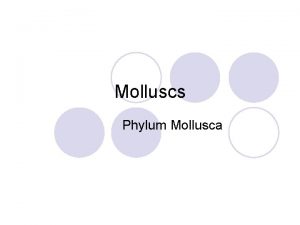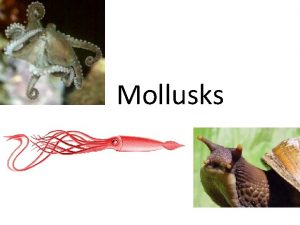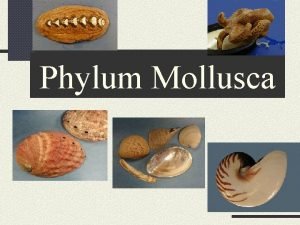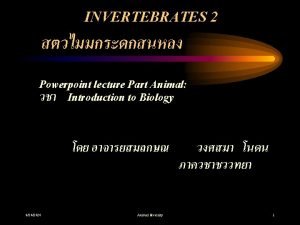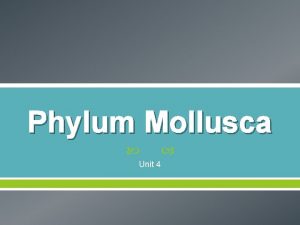Mollusks Phylum Mollusca Includes snails and slugs oysters






































- Slides: 38

Mollusks

Phylum Mollusca • Includes snails and slugs, oysters and clams, and octopuses and squids. Bivalves Nautilus

Characteristics • Soft-bodied invertebrate • Covered with protective mantle that may or may not form a hard, calcium carbonate shell • Second largest animal phylum • Have a muscular foot for movement which is modified into tentacles for squid & octopus

Characteristics • Complete, one-way digestive tract with a mouth & anus • Have a fully-lined coelom • Cephalization - have a distinct head with sense organs & brain • Have a scraping, mouth-like structure called the radula • Go through free-swimming larval stage called trochophore

Phylum Mollusca • Most mollusks are marine • Some gastropods and bivalves inhabit freshwater • A few gastropods (slugs & snails) are terrestrial.

Humans & Mollusks • Uses: – As food – mussels, clams, oysters, abalone, calamari (squid), octopus, escargot (snails), etc. – Pearls – formed in oysters and clams. – Shiny inner layer of some shells used to make buttons.

Mollusk Pests • Shipworms – burrow through wood, including docks & ships. • Terrestrial snails and slugs damage garden plants. • Mollusks serve as an intermediate host for many parasites. • Zebra mussels – accidentally introduced into the Great Lakes and reeking havoc with the ecosystem.

Mollusk Body Plan All mollusks have a similar body plan with three main parts: 1. Muscular foot 2. Visceral mass – containing digestive, circulatory, respiratory and reproductive organs. 3. Mantle – houses the gills and in some secretes a protective shell over the visceral mass.

Mollusk Body Plan • Most mollusks have separate sexes with gonads located in the visceral mass.

Head-Foot Region • Most mollusks have well developed head ends with sensory structures that may be simple light detectors or complex eyes (cephalopods).

Head-Foot Region • The radula is a rasping, tongue like feeding structure found in most mollusks except bivalves. • Has tiny rows of teeth for scraping.

Shells • Found in snails, bivalve mollusks, chitons, and nautilus • Made of calcium carbonate (limestone) • Secreted by the mantle


Internal Structure & Function • Many mollusks have an open circulatory system with a pumping heart, blood vessels and blood sinuses. • Most cephalopods (squid & octopus) have a closed circulatory system with a heart, blood vessels and capillaries.

Mantle Cavity • The space between the mantle and the visceral mass (body organs) is called the mantle cavity. • The respiratory organs (gills or lungs) are generally housed here.

Mollusk Life Cycle • Most mollusks are dioecious (separate sexes) • Some are hermaphroditic • The life cycle of many mollusks includes a free swimming, ciliated larval stage called a TROCHOPHORE

Major Mollusk Classes • 5 major classes of mollusks: – Class Polyplacophora – the chitons – Class Gastropoda – snails & slugs – Class Bivalvia – clams, mussels, oysters – Class Cephalopoda – octopus & squid – Class Scaphopoda-”tusk shells”

Class Polyplacophora • Includes the chitons • Eight overlapping plates • Can roll up • Live mostly in the rocky intertidal zones. • Use radula to scrape algae off rocks. • Water flows over gills to respire

Class Scaphopoda • Includes the tusk shells. – Found in subtidal zone to 6000 m deep. – Mantle wraps around visceral mass and is fused, forming a tube.

Class Gastropoda • Gastropoda is the largest of the mollusk classes. • 70, 000 named species. • Include snails, slugs, sea hares, sea slugs, sea butterflies. • Marine, freshwater, terrestrial. • Slugs lack a shell!

Class Gastropoda • The shell of a gastropod is always one piece – univalve – and may be coiled or uncoiled. • The apex contains the oldest and smallest whorl. • Shells may coil to the right or left – this is genetically controlled.

Class Gastropoda • Many snails can withdraw into the shell and close it off with a horny operculum.

Gastropod Feeding Habits • Most gastropods are herbivores and feed by scraping off algae using the radula. • Some are scavengers of dead organisms • Others are carnivores that drill into other mollusks

Class Bivalvia • Bivalve mollusks have two shells (valves). • Mussels, clams, oysters, scallops, shipworms. • Mostly sessile filter feeders. • No head or radula.

Class Bivalvia • • Laterally (right-left) compressed shell Shells are held together by a hinge ligament Umbo is the oldest part of the shell Growth occurs in concentric rings around it.

Class Bivalvia • Incurrent and excurrent siphons are used to pump water through the organism for: 1. Gas exchange 2. Filter feeding 3. Jet propulsion.

Class Bivalvia - Locomotion • Bivalves move around by extending the muscular foot between the shells. • Scallops and file shells swim by clapping their shells together to create jet propulsion. http: //www. youtube. com/watch? v=u_Rfgv. IETEY&feature=related http: //www. youtube. com/watch? v=vmi_I 8 QW 5 eo

Class Bivalvia • Like other mollusks, bivalves have a coelom and an open circulatory system. • They breathe through gills and filter feed


Class Bivalvia • Scallops have a row of small blue eyes along the mantle edge. Each eye has a cornea, lens, retina, and pigmented layer.

Class Cephalopoda • Cephalopods include octopuses, squid, nautiluses and cuttlefish. • Marine carnivores with beak-like jaws Surrounded by tentacles modified from their foot.

Class Cephalopoda - Shells • Shells of the Nautilus are made buoyant by a series of gas chambers.

Class Cephalopoda - Shells • Cuttlefish have a small curved shell, completely enclosed by the mantle.

Class Cephalopoda - Shells • In squid, the shell has been reduced to a small strip called the pen, which is enclosed in the mantle.

Class Cephalopoda - Locomotion • Cephalopods swim by expelling water from the mantle cavity through a ventral funnel.

Class Cephalopoda • Most cephalopods have complex eyes with cornea, lens, chambers, and retina. • Largest invertebrate brain • Closed circulation

Protection • Color changes effected by chromatophores (pigment cells) • Allows them to blend into their background • Squirting out water by jet propulsion helps escape predators • Squids also release an inky substance into the water

Class Cephalopoda - Reproduction • Sexes are separate in cephalopods. • Juveniles hatch directly from eggs – no free-swimming larvae. • One arm of male removes a spermatophore from mantle cavity and inserts it into female.
 Life cycle of slug
Life cycle of slug Invertebrates including snails slugs and mussels
Invertebrates including snails slugs and mussels Invertebrates including snails slugs and mussels
Invertebrates including snails slugs and mussels Whats a mollusc
Whats a mollusc Oysters phylum
Oysters phylum Phylum
Phylum Phylum mollusca homework and study guide #1
Phylum mollusca homework and study guide #1 Limpets phylum
Limpets phylum Phylum mollusca characteristics
Phylum mollusca characteristics Class gastropoda
Class gastropoda Scaphopoda
Scaphopoda Mollusca characteristics
Mollusca characteristics Class monoplacophora characteristics
Class monoplacophora characteristics 3 classes of mollusks
3 classes of mollusks Cell respiration virtual lab
Cell respiration virtual lab Pancake slugs
Pancake slugs How to read a cladogram
How to read a cladogram Rabbit food chain
Rabbit food chain Mystery snail slime
Mystery snail slime Are snails bugs
Are snails bugs Are snails coelomates pseudocoelomates or acoelomates
Are snails coelomates pseudocoelomates or acoelomates Two shellfish
Two shellfish Sol azul oysters
Sol azul oysters Oysters
Oysters Othniel oysters ltd
Othniel oysters ltd Mollusks
Mollusks Chapter 25 worms and mollusks worksheet answers
Chapter 25 worms and mollusks worksheet answers Section 4 flatworms mollusks and annelids
Section 4 flatworms mollusks and annelids Section 4 flatworms mollusks and annelids
Section 4 flatworms mollusks and annelids Section 4 flatworms mollusks and annelids
Section 4 flatworms mollusks and annelids Characteristics of worms
Characteristics of worms 5 advanced characteristics shared by cephalopods
5 advanced characteristics shared by cephalopods Section 27-3 annelids
Section 27-3 annelids Chapter 27 worms and mollusks
Chapter 27 worms and mollusks Mollusks arthropods and echinoderms
Mollusks arthropods and echinoderms Mollusca examples with names
Mollusca examples with names Section 27-4 mollusks
Section 27-4 mollusks Chapter 25 section 1 flatworms answer key
Chapter 25 section 1 flatworms answer key Segmentation in mollusca
Segmentation in mollusca
